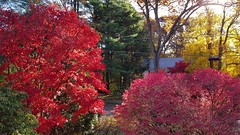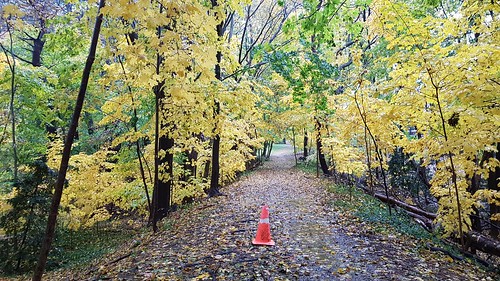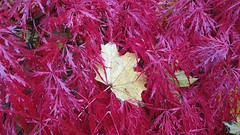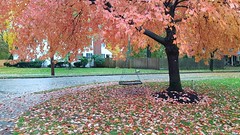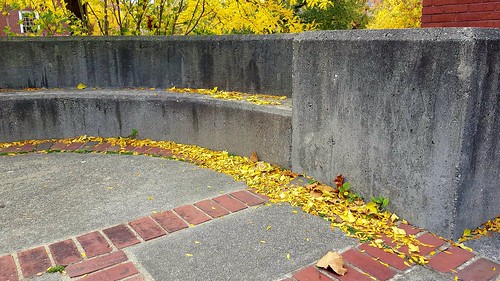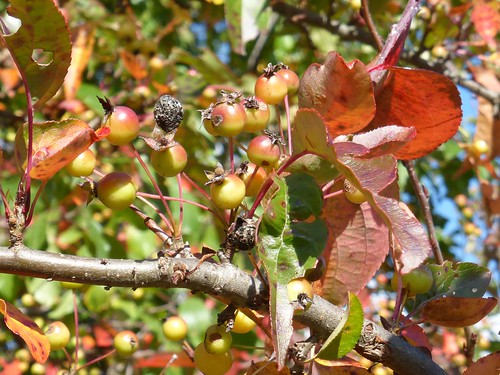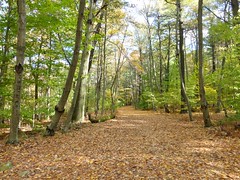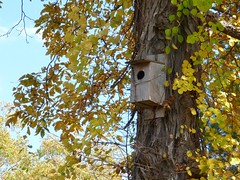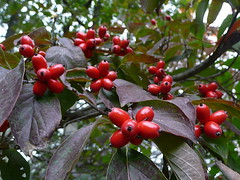
This past weekend was sunny, so the trees glowed as if someone had turned them on with a switch.

Leslee has blogged the TVs of others, and Maria has blogged others’ dreams. On a weekend when many New Englanders headed to New Hampshire to peep northern leaves, I was considering the leaves of others in Massachusetts: the neon flashes of foliage seen during my routine weekend morning dog-walks in Newton.
I’ve spend spending my weekends in Newton for several months now, and I’m still not comfortable taking photos of the residential neighborhoods there. In Keene, I’ve been snapping impertinent pictures for over three years, so my neighbors have grown accustomed to that crazy woman who walks her dog with a camera. In Keene, I have no qualms about walking into the middle of a quiet residential street, crouching on my hams, and shooting whatever strikes my fancy; if someone were to question my odd behavior, I’d simply respond that I live here. For good or ill, I haven’t attained that level of comfort in Newton. Although these days I spend more time in Newton than I do in Keene, I still don’t feel like I live there. My mailing address remains in Keene, as do most of my belongings, and Keene is where I pay my own rent, utilities, and other necessities of “Real Life.”

In Newton, I still feel like an interloper, as if at any moment the Propriety Police will come upon me unannounced and escort me from the place: “I’m sorry, but your kind isn’t welcome here.” I’m not sure where or why I’ve gotten this impression: it’s not as if anyone in Newton or elsewhere in Massachusetts has ever treated me like an unwelcome outsider. Perhaps my unease stems from my earliest days in New England, when I was a fresh-faced graduate student at Boston College and couldn’t afford to live in Chestnut Hill, the tony Newton neighborhood near campus. I still can’t afford to live in Newton, even more than a decade (and a completed PhD) later. Profs and professionals abound in Newton, which boasts an inordinate concentration of people with PhDs…and yet when I walk the streets there, I’m acutely aware that my adjunct instructor’s paycheck does not reflect my academic credentials. Although I really am a doctor, I typically feel like I only play one in academe. In a lush and leafy neighborhood where people drive nice cars, live in even nicer homes, and enjoy other accoutrements of financial success, at times I feel like I’m only playing house.

When I first began teaching as a graduate student at Boston College, back when I lived a long subway-ride away in relatively affordable, working-class Malden, my grad student colleagues and I used to discuss our lingering sense of fraudulence. Standing in front of a classroom of freshmen, we felt we were faking it, our knowledge only diploma-deep. Surely if the Real Professors in our midst could detect phoniness like a stench in the breeze, they’d sniff us out for sure. When would our freshmen, we wondered amongst ourselves, figure out that we were clueless students just like they were, only a couple years’ older?
More than a decade (and a completed PhD) later, I still feel like a fraudulent faker: I somehow feel it’s only a matter of time before some intrepid Toto pulls back the curtain and reveals my show as sham. Walking the streets of a lush suburb populated by the Settled and Successful, I feel more like the clueless graduate student I was than the presumed professional I’ve become. At what point, I wonder, will someone figure out I don’t belong in Newton but am simply faking it?

Newton, like other surrounding suburbs, is a bedroom community for Boston, and I’m mindful that most folks don’t like strangers snapping pictures in their bedrooms. On Sunday when I snapped these shots of the turning leaves and neighboring houses I regularly see when I walk Reggie there, I did so semi-surreptitiously. It felt weird to be ogling other people’s leaves, as if leaf-peeping and window-peeping share more than a common gerund. Would people mind if I shot images of “their” houses even if I did so from the public space of a city sidewalk? Would homeowners be rightfully protective of “their” trees? Emerson claimed that poets are the only ones who own the landscape, for “There is a property in the horizon which no man has but he whose eye can integrate all the parts.” But still, the citizens of Newton pay a pretty penny for the privacy their abundantly leafy trees afford; isn’t it somehow criminal–or at least morally suspect–to intrude?

Faced with the ethical question to shoot or not to shoot, I chose the former. Given the number of visiting Massachusetts leaf-peepers I’ve shared New Hampshire roads with over the years, it seemed fitting to return the compliment. There’s plenty of landscape, I think, to satisfy poets, profs, and professionals alike, at least from the suburban safety of Newton’s streets and sidewalks. If we can share the road, presumably we can share the gleaming autumn leaves that right now are screening our sky.
Click here for a photo-set of images from Sunday’s dog-walk. Enjoy!


